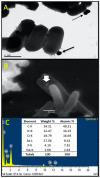Selenium Nanoparticle-Enriched and Potential Probiotic, Lactiplantibacillus plantarum S14 Strain, a Diet Supplement Beneficial for Rainbow Trout
- PMID: 36290428
- PMCID: PMC9598509
- DOI: 10.3390/biology11101523
Selenium Nanoparticle-Enriched and Potential Probiotic, Lactiplantibacillus plantarum S14 Strain, a Diet Supplement Beneficial for Rainbow Trout
Abstract
Lactic acid bacteria (LAB), obtained from rainbow trout (Oncorhynchus mykiss) intestine, were cultured in MRS medium and probiotic candidates. Concurrently, producers of elemental selenium nanoparticles (Se0Nps) were selected. Probiotic candidates were subjected to morphological characterization and the following tests: antibacterial activity, antibiotic susceptibility, hemolytic activity, catalase, hydrophobicity, viability at low pH, and tolerance to bile salts. Two LAB strains (S4 and S14) satisfied the characteristics of potential probiotics, but only strain S14 reduced selenite to biosynthesize Se0Nps. S14 strain was identified, by 16S rDNA analysis, as Lactiplantibacillus plantarum. Electron microscopy showed Se0Nps on the surface of S14 cells. Rainbow trout diet was supplemented (108 CFU g-1 feed) with Se0Nps-enriched L. plantarum S14 (LABS14-Se0Nps) or L. plantarum S14 alone (LABS14) for 30 days. At days 0, 15, and 30, samples (blood, liver, and dorsal muscle) were obtained from both groups, plus controls lacking diet supplementation. Fish receiving LABS14-Se0Nps for 30 days improved respiratory burst and plasmatic lysozyme, (innate immune response) and glutathione peroxidase (GPX) (oxidative status) activities and productive parameters when compared to controls. The same parameters also improved when compared to fish receiving LABS14, but significant only for plasmatic and muscle GPX. Therefore, Se0Nps-enriched L. plantarum S14 may be a promising alternative for rainbow trout nutritional supplementation.
Keywords: Oncorhynchus mykiss; ROS; lysozyme; nutritional supplement; oxidative stress; probiotic; production parameters; rainbow trout; selenium nanoparticles.
Conflict of interest statement
The authors declare no conflict of interest.
Figures






Similar articles
-
Selenium Nanoparticles Biosynthesized by Pantoea agglomerans and Their Effects on Cellular and Physiological Parameters in the Rainbow Trout Oncorhynchus mykiss.Biology (Basel). 2022 Mar 17;11(3):463. doi: 10.3390/biology11030463. Biology (Basel). 2022. PMID: 35336836 Free PMC article.
-
Dietary cosupplementation with curcumin and different selenium sources (nanoparticulate, organic, and inorganic selenium): influence on growth performance, body composition, immune responses, and glutathione peroxidase activity of rainbow trout (Oncorhynchus mykiss).Fish Physiol Biochem. 2019 Apr;45(2):793-804. doi: 10.1007/s10695-018-0585-y. Epub 2018 Nov 3. Fish Physiol Biochem. 2019. PMID: 30392099
-
Influence of the forms and levels of dietary selenium on antioxidant status and oxidative stress-related parameters in rainbow trout (Oncorhynchus mykiss) fry.Br J Nutr. 2015 Jun 28;113(12):1876-87. doi: 10.1017/S0007114515001300. Epub 2015 May 20. Br J Nutr. 2015. PMID: 25990817
-
Modulatory effect of dietary copper nanoparticles and vitamin C supplementations on growth performance, hematological and immune parameters, oxidative status, histology, and disease resistance against Yersinia ruckeri in rainbow trout (Oncorhynchus mykiss).Fish Physiol Biochem. 2022 Feb;48(1):33-51. doi: 10.1007/s10695-021-01036-2. Epub 2021 Nov 30. Fish Physiol Biochem. 2022. PMID: 34850306
-
Expression of immune-related genes in rainbow trout (Oncorhynchus mykiss) induced by probiotic bacteria during Lactococcus garvieae infection.Fish Shellfish Immunol. 2011 Aug;31(2):196-201. doi: 10.1016/j.fsi.2011.05.005. Epub 2011 May 19. Fish Shellfish Immunol. 2011. PMID: 21620974
Cited by
-
Impact of Selenium Nanoparticle-Enriched Lactobacilli Feeding Against Escherichia coli O157:H7 Infection of BALB/c Mice.Probiotics Antimicrob Proteins. 2024 Jun;16(3):784-795. doi: 10.1007/s12602-023-10081-7. Epub 2023 May 5. Probiotics Antimicrob Proteins. 2024. PMID: 37145299
-
Nano selenium-enriched probiotic Lactobacillus enhances alum adjuvanticity and promotes antigen-specific systemic and mucosal immunity.Front Immunol. 2023 Jan 27;14:1116223. doi: 10.3389/fimmu.2023.1116223. eCollection 2023. Front Immunol. 2023. PMID: 36793732 Free PMC article.
-
Biosynthesis of selenium nanoparticles by lactic acid bacteria and areas of their possible applications.World J Microbiol Biotechnol. 2023 Jun 21;39(9):230. doi: 10.1007/s11274-023-03673-6. World J Microbiol Biotechnol. 2023. PMID: 37341841 Review.
-
Amelioration of inflammatory bowel disease by Bifidobacterium animalis subsp. lactis XLTG11 in combination with mesalazine.Front Microbiol. 2024 Dec 4;15:1472776. doi: 10.3389/fmicb.2024.1472776. eCollection 2024. Front Microbiol. 2024. PMID: 39697653 Free PMC article.
-
Dietary Effects of Selenium Nanoparticles on Growth Performance, Survival Rate, Chemical Composition, and Muscle Bioaccumulation of Nile Tilapia (Oreochromis niloticus).Biol Trace Elem Res. 2024 May;202(5):2308-2313. doi: 10.1007/s12011-023-03836-4. Epub 2023 Sep 14. Biol Trace Elem Res. 2024. PMID: 37707756
References
-
- Iversen A., Asche F., Hermansen Ø., Nilstøyl R. Production cost and competitiveness in major salmon farming countries 2003–2018. Aquaculture. 2020;522:735089. doi: 10.1016/j.aquaculture.2020.735089. - DOI
-
- Subpesca . Informe Ambiental de la Acuicultura. Subsecretarıa de Pesca y Acuicultura, Ministerio de Economía, Gobierno de Chile; Santiago, Chile: 2017. 91p
LinkOut - more resources
Full Text Sources
Other Literature Sources
Molecular Biology Databases
Miscellaneous

